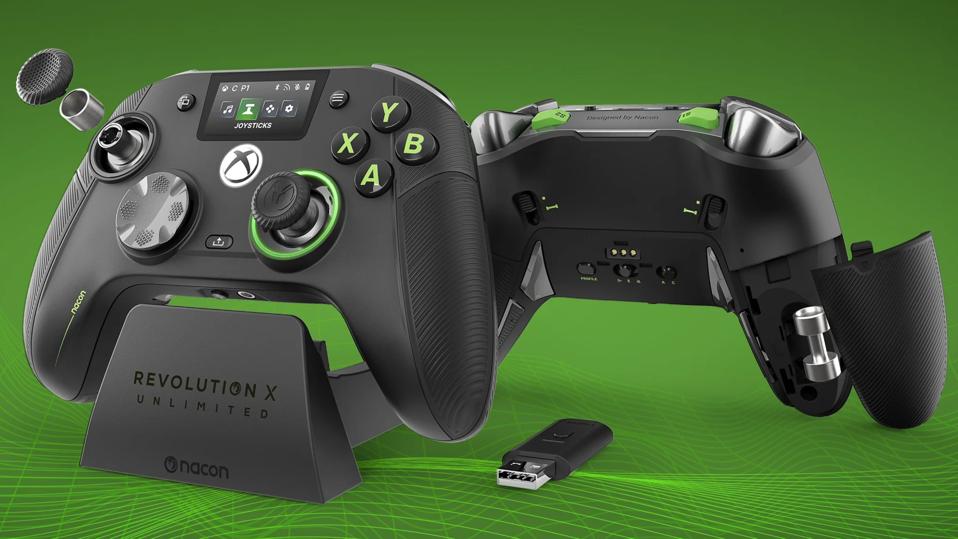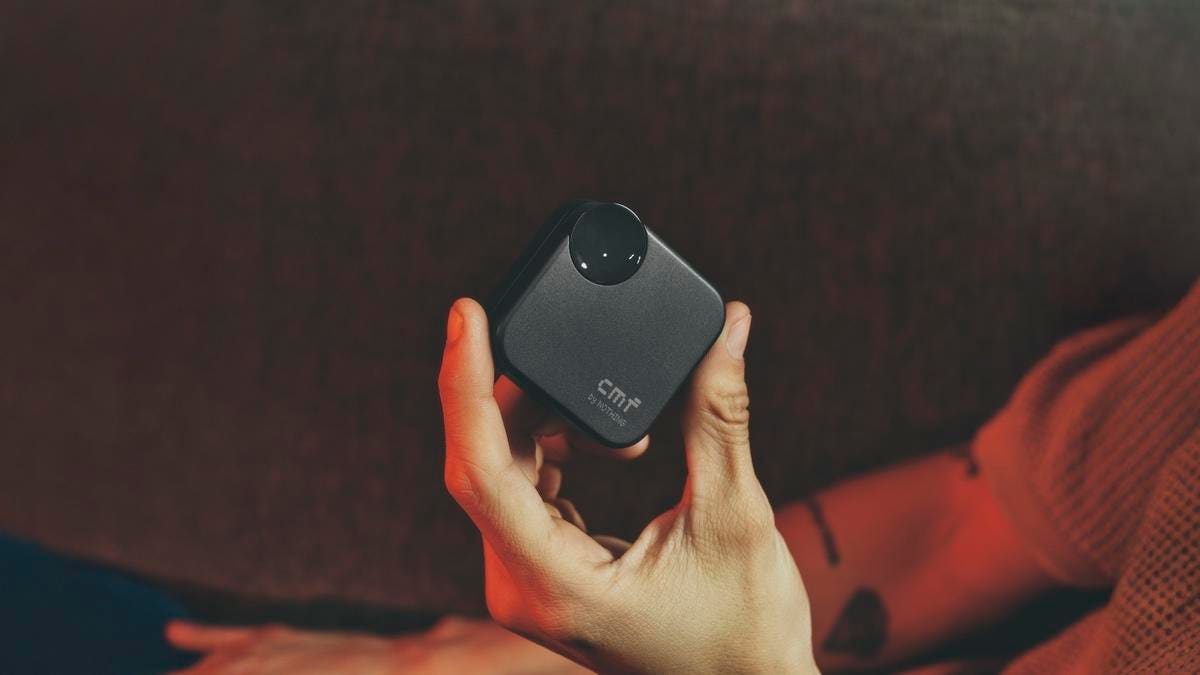Nacon’s Revolution X Unlimited might be the best third-party controller for the Xbox, and arguably … More
When it was announced in August 2024, Nacon’s Revolution X Unlimited for Xbox and PC looked like it had the chops to become the best Elite-style pad yet. It has form; it’s based on the superb Revolution 5 Pro for PS5, which is one of the best third-party controllers out there.
With such high expectations, it’s great to confirm that it delivers on its promises. The Revolution X Unlimited joins Victrix’s Pro BFG at the top of the pile for Xbox and PC players — another peripheral that not only beats Microsoft’s first-party Elite 2 but also carves a unique niche in the market, with the RXU even separating itself from the Pro BFG’s more fighter-focused design. In all honesty, it’s my favorite Xbox pad yet, even if it might not be yours.
What’s in the box?
Channeling the hallmarks of the Rev 5, the Revolution X Unlimited comes with an almost identical setup, but with a nice extra in the form of a charging stand (and, dear reader, that’s for good reason). Here’s what’s inside:
- Revolution X Unlimited controller fitted with disc D-pad and two concave joystick heads
- Hard-shell storage case with microfiber cloth
- USB dongle
- USB-C cable (3m)
- Charging dock
- Accessory storage box, containing:
- Four-way D-pad
- Six weights (two 10g, two 14g, two 16g)
- Metal joystick rings (two 30°, two 38°)
- Four convex joystick heads (two standard, two deep)
Everything in its right place.
Play Puzzles & Games on Forbes
Core features of the Revolution X Unlimited
Of course, there’s more underneath the hood, including:
- Hall-effect joysticks to counteract long-term drift issues;
- Mechanical face buttons;
- Adjustable triggers with micro-switch components;
- Six additional configurable shortcut buttons (four behind the pad, two inset from the triggers);
- Four vibration motors (two in the handles, two in the triggers);
- An LCD screen for button mapping, programming, and audio mixing;
- 10 hours of battery life;
- App support for up to four profiles;
- 2.4GHz USB radio frequency and Bluetooth (compatible with Android); and
- 1ms wired and 2ms wireless latency.
The contents of the Nacon Revolution X Unlimited package (without case and microfiber cloth).
First impressions
When you first hold the Revolution X, two things surprise you. Firstly, it’s probably the biggest Xbox controller out there — while it sits comfortably in my larger-than-average hands, it still feels bulky. Its finish is lightly rubberized, meaning it won’t slip from your grasp.
Secondly, it’s surprisingly light, despite its size — just 327g, compared to the standard Xbox controller’s 306g. If anything, it feels too light for its shape. I opted for the 14g weights on both sides, which made it feel just right. Fitting these is a breeze, and the same thing can be said for the sticks and D-pad toppers. Admittedly, I prefer the out-of-the-box set-up with concave stick heads and the dish D-pad cover, but the Revolution X Unlimited doesn’t fall foul of a four-way D-pad that’s seemingly impossible to remove once it’s placed.
Across the board, the RXU’s buttons and triggers are incredibly quiet. The mechanical face buttons aren’t silent, but you wouldn’t want them to be; they’re just muted enough to provide the satisfaction of inputs beyond simple haptics.
Perhaps most importantly — given the competition mentioned above — the RXU’s trigger stops also benefit from shoulder dampeners, meaning that hairline fans aren’t met with insufferable clacking in FPS games. It’s such a simple thing to get wrong, but most high-end controllers seem to fall foul of this problem.
You’ll maybe want to add weights to the RXU, if only to get the “real feel” for its size.
Ultra responsive
Mechanical buttons are a must for any controller at this price point, but their responsiveness is incredible. The difference between wired (1ms) and wireless (2ms) input lag is minimal, but the resistance provided by the face buttons is essentially faultless, so the difference is outright indiscernible.
The same quality can be found with the additional S3-S6 buttons on the rear, which you never find yourself pressing accidentally, even in more fraught firefights. I always map throwables and reload to them, and I never once found myself dead via self-inflicted misadventure.
Undoubtedly, the D-pad is the star of the show, especially with the pre-fitted dish piece. You feel all degrees, especially during trickier combos and quarter-turn or semi-circular maneuvers on Tekken or Street Fighter. What’s more, I think it’s the first controller where I’ve genuinely felt every direction to such a degree that I never felt like I missed my chosen input.
However, the LB, RB, and bonus S1 and S2 buttons — inset from the triggers — have a bit more of a basic feel, and certainly don’t feel mechanical. That’s not to say they’re bad, and not any worse than standard Xbox controllers; the S1 and S2s still feel satisfying to use, providing you have fingers long enough to let them sit comfortably under your prints.
Finally, a decent app
One thing that many controller manufacturers get wrong is the app. The Pro BFG’s suite was only available on PC at launch; the PowerA Fusion Pro had a more lightly adapted PC app with limited functionality; the Thrustmaster eSwap Pro 2’s software struggled to connect at the best of times.
The RXU’s app is straightforward enough.
There’s no doubt the Nacon RXU app for the Xbox is good, but it’s not great; set-up is a chore, and for me, it struggled to connect on the first couple of tries. There’s no such issue on the PC, which is usually better to use anyway. Being able to map four profiles, with handy colors to distinguish them, is straightforward. Reassigning buttons on the fly without the app is easy enough, too; you don’t need a degree in software engineering to figure it out from the manual.
I’m picking up weird vibrations
The one thing you may struggle to overcome is the RXU’s vibration. Unlike the Revolution 5, which lacked official Sony status and so didn’t vibrate at all, this Microsoft-approved peripheral can be way too loud. Feedback itself is mostly great — the four motors work nicely — but at its worst, it might drown out your TV.
Admittedly, this tends to be more of a problem with games that aren’t quite its forté — not so much Tekken 8, Call of Duty: Black Ops 6, or even Halo Infinite, but given how much I love this controller, I was using it for everything. It really hit a high with To a T, where I wondered if it was trying to sing like the Nintendo Switch 2’s JoyCons in Welcome Tour. Still, you can adjust the intensity via the app, at the same time you inevitably adjust the deadzones of your sticks.
Everything you need, whatever you play
As with any high-end controller, you have to question value for money, and chief among these is the $200 Nacon RXU. It’s the most expensive controller I’ve ever held — even the Elite Series 2 is $160 right now — so it naturally needs to justify the tag, especially when it lacks the swappable elements of the Pro BFG or eSwap Pro 2.
Sure, some things don’t quite stack up for the Revolution X Unlimited. The ten-hour battery life isn’t great, but at least it comes with a nice charger dock when you inevitably return to real life, even if the pad doesn’t offer a show like the PowerA Fusion Pro Wireless. The weight and size might put people off, but as one of the larger humans on this planet (on both the X and Y axes), I love it, even if returning to a regular Xbox controller is like going from a Sports Direct mug to an espresso cup.
Despite having three different types of Xbox controllers on rotation depending on my mood or the game, I only ever picked up the Revolution X Unlimited while I had it. It’s been with me through Clair Obscur: Expedition 33, S.T.A.L.K.E.R. Shadow of Chornobyl, Metal Gear Solid, Forza Horizon 5, To a T, Ultimate Marvel vs Capcom 3, and even SEGA Mega Drive Classics, and never felt out of place. It just consistently does the job — to a tee, if you will.









